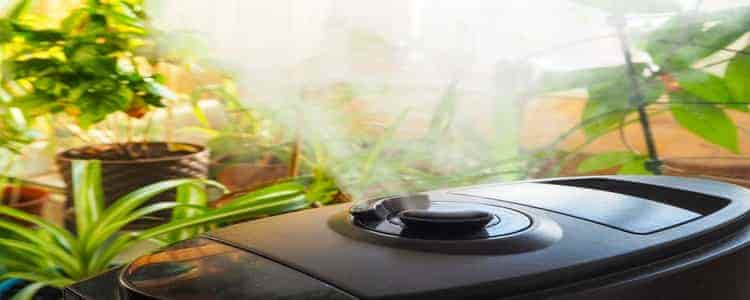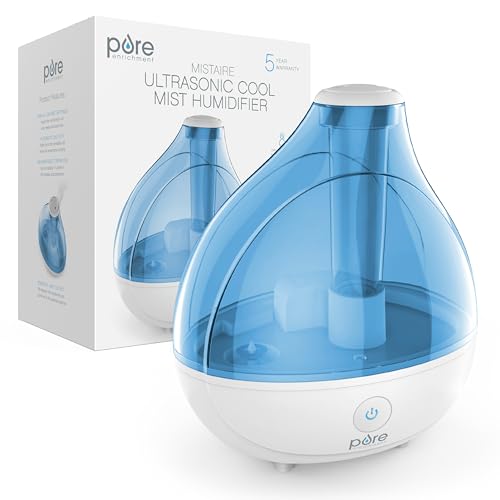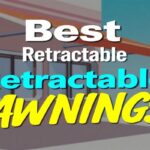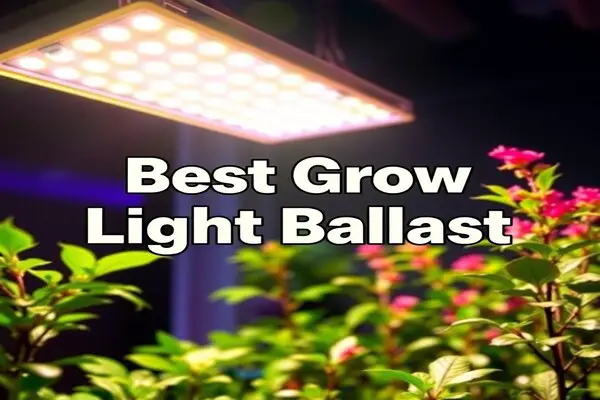Humans aren’t the only ones who suffer from the effects of the cold, dry air during the winter months – plants do, too! While we experience skin irritations and allergic reactions, our plants become dull and wilted, if not nearly lifeless, too. Our decision to buy the best plant humidifiers for indoor plants and greenhouse will then be beneficial for our health and our plants’ health. Yes, indeed, these humidifiers are suitable for both human and plant use so we’re essentially killing two birds with one stone. In this best plant humidifiers for indoor plants and greenhouse review section, we are going to review five of the plant humidifier that we think is the best according to our point of view.
Best plant humidifiers for indoor plants and greenhouse
1.Honeywell HCM350W Germ Free Cool Mist Humidifier White
The popularity of the Honeywell HCM350W humidifier can be attributed to its efficacy, ease of use, and portability. With its 1-gallon tank capacity, it can increase moisture in the air for up to 24 hours when it’s on low setting; the duration becomes shorter on medium and high settings. There’s no need for frequent refills of water, a convenient feature when you’re usually out of the house during the day.
You can install it inside our large living room, bedroom or kitchen where plants require moisture, as well as in a small-sized greenhouse. You can also rely on it to kill 99.9% of bacteria that lives in water so our plants aren’t exposed to more pathogens.
It has a wicking filter that absorbs minerals found in water and, thus, prevents them from being released into the air. Many inferior humidifiers have a white dust around them, a sign that these aren’t working as well as expected in filtering out pathogens.
Don’t worry about adding more moisture into the air when the Honeywell humidifier is on, thanks to its evaporative technology. Just make sure that it’s filled with water to the right level so that our plants aren’t exposed to dry, brittle air longer than necessary.
When used properly, it’s a great tool for maintaining the health of our indoor plants, especially the ones requiring high moisture, during the winter months.
Pros:
- Plug-and-play installation
- Ultra-quiet operation even on high setting
- Effectively adds moisture to the air over a 24-hour period
- Easy to clean and refill with water
Cons:
- No automatic shut-off control
- Expensive for some people
2. Ultrasonic Cool Mist Humidifier
The 1.6-gallon tank capacity of the Everlasting Comfort ultrasonic humidifier makes it ideal for larger rooms up to 400 square feet! With its 270 ml/hour mist output, it will moisturize the air for up to 50 hours, far longer than many humidifiers in the market. You can fill its tank up to its full capacity, turn it on, and leave the house, if you want, without worrying about our indoor plants being wilted by the time you come back.
Unlike a warm mist humidifier, it doesn’t make the air warmer, a useful feature when our indoor plants thrive in cool conditions. You can then use it year-round since cool air is definitely welcome during the summer months. You don’t even have to add cool or cold distilled water into its tank since the humidifier cools the water on its own.
We love that it has adjustable settings, too, which makes for easy customization depending on the size of the room, the weather conditions, and the number of indoor plants. You can adjust the amount of mist and steam that it generates, thanks to its easy-to-use control knob, and rely on the 360-degree rotating nozzles for even mist distribution.
The bottom line: You can adjust our desired level of humidity with it, from low to high, so our indoor plants can thrive regardless of the season.
Pros:
- Large tank capacity
- Evenly distributes cool air for several hours
- With automatic shut-off for safety and efficiency
- Quiet operation
Cons:
- White dust will form when it’s used with tap water
- May be slightly difficult to clean
3.Pureguardian H965 Ultrasonic Cool Mist Humidifier
The 13-inch Pure Guardian humidifier creates mist through a vibrating metal diaphragm instead of a fan. The result is an ultra-quiet operation, a bonus when you want peace and quiet in our living areas or in our greenhouse. But even if you hear an underlying hum, as many people still do, you will likely agree that it is white noise that masks the annoying background noise of everyday life.
As its name suggests, it produces cool mist that makes whatever room it’s placed in cooler, a good benefit during the summer months when indoor plants become drier and duller due to the hot air. Even in winter, it’s still an ideal choice since it increases moisture into the dry, brittle air without resulting in noticeably lower temperature.
When its 1-gallon tank is full, it can create mist for 15 to 70 hours depending on its speed setting, the size of the room, and the atmospheric conditions. Set it on low speed for longer mist production and on high speed when the air’s drier than usual. There’s less need for frequent refills, too, thanks to its relatively large tank capacity.
We love it that this humidifier has Silver Clean Protection, a feature that prevents the build-up of minerals, dirt and dust in the humidifier. It’s an important feature because it inhibits the growth of mold and mildew inside the tank; mold and mildew can cause health issues in humans and plants.
Pros:
- Effective in adding moisture to the air for several hours
- Automatically shuts off with an empty tank
- Comes with anti-mold and mildew feature
- Requires little maintenance (i.e., no replacement filters needed)
Cons:
- Produces white dust when used with tap water (i.e., white dust on leaves has negative effects)
- Less than easy to transport (i.e., no handle)
4.Pure Enrichment Mistaire Ultrasonic Cool Mist Humidifier
The 1.5-liter water tank capacity of the Pure Enrichment Mistaire humidifier means that it produces mist for up to 16 hours at a time. While it doesn’t seem long enough for some people, it is sufficient when a higher humidity level is required for a shorter period, say, overnight. The number of hours the humidifier creates mist also depends on the speed setting – low and it’s longer; high and it’s shorter obviously.
What it lacks in large tank capacity it more than makes up for in the ease of filling the tank with water. You can fill it with water straight from the kitchen sink or garden hose. But we don’t suggest using tap water since the minerals in it can form white dust, which can settle on the leaves and affect their health; distilled water is best in humidifiers.
With its 360-degree mist nozzle, it allows for a more even mist distribution as well as for directing mist away from certain things (e.g., electronics and upholstery). Be sure to direct most of the mist away from our indoor plants since there’s such a thing as too much moisture for them.
The humidifier also has an automatic shut-off feature when the water tank has been removed or when the water level in the tank is low. This is a safety feature suitable for both homes and greenhouses.
Pros:
- Effective and efficient operation
- Fairly easy to clean
- Runs for several hours before a refill is needed
- Comes with two speed settings and with night light
Cons:
- May produce white noise (i.e., not so silent)
- Top nozzle has two parts
5.Pure Enrichment Mistaire Silver Ultrasonic Cool Mist Humidifier
This Pure Enrichment cool mist humidifier has a larger tank capacity and longer operating hours. It can run for 25 hours on a single full tank of water. But many users also say that it can run for two days without needing a refill, especially when it’s on low setting or when the air’s relatively humid. The bottom line here is that it’s an effective humidifier because it does what it’s supposed to do – add moisture to air – and cost-efficient, too.
We like that it has a nice design that won’t look out of place among stylish knick-knacks on the table. Plus, it’s so easy to set up and operate – just fill the tank with water, replace it on the humidifier, and turn it on. You can choose the settings depending on whether you want a low mist or a high mist, with or without the nightlight on.
During the night when the air tends to be drier, it’s best to use it on high setting with the night light on. This way, our indoor plants – and you, for that matter – will be able to sleep through the night.
While it makes a soft noise during operating, it’s fairly quiet. Think of it as a sort of white noise that can lull you to sleep, if you want.
Pros:
- Nice aesthetics and size
- Easy to operate and clean
- Effective and efficient operation
- Inhibits mold and mildew formation
Cons:
- Cleaning can be a bit difficult
- Instructions on cleaning aren’t clear
The Basic idea about plant humidifier

Well, if you are reading this review article about the best plant humidifiers then there is a high chance that you already have a basic idea about what are humidifiers?But still we are going to describe some basic fundamental about humidifier. We’ll also talk about their benefits in our home in this section. Humidifiers are devices designed to increase the level of humidity or amount of moisture in the air. These are typically small enough to be placed on a table, on a shelf, or on the floor thus their popularity in homes, offices and greenhouses. These are obviously popular during the autumn and winter months when the air is dry, brittle and cold.
While there are several types of humidifiers, their basic workings and functions are similar. Humidifiers introduce moisture into indoor air by creating an invisible mist. That, in turn, makes the air less dry and brittle.
The types of humidifiers and their basic workings include:
- Ultrasonic humidifiers create micro0fine water droplets through an ultrasonic vibrating diaphragm.
- Cool mist humidifiers work by distributing moisture into the air and making the room feel cooler. These are popular for year-round use, even during the summer when the air seems drier than usual.
- Warm mist humidifiers contribute to warmer indoor temperatures during the cold winter months. These work by heating the water to boiling point until the water vaporizes and adds heat to the air.
None of these humidifiers are better than the others! Each one has its pros and cons, and our choice will depend on our personal preferences.
Why Do Some Plants Need Higher Humidity?
Natural Adaptation Ability:
Plants adapt to their native environment. Their adaptation includes the natural ability to increase or decrease their water absorption and retention. Succulents, for example, can hold plenty of water in their leaves. This is a part of their adaptation in the dry, arid air of the desert. Boston fern, African violets, and peace lilies, in contrast, need high humidity.
Due to Less robust root systems:
Many plants with less robust root systems also need high humidity environments. This is because their roots are less able to efficiently draw water from the soil . So they are less likely to retain water in their leaves.
Thin Leaves system:

Many plants with thin leaves also have difficulty absorbing and retaining water thus they require higher humidity levels. As a general rule, the thinner the leaves on a plant, the higher the need for humidity. This is because the thin tissues of the leaves allow for more water evaporation. Hence, puts the plants at a higher risk for dying when the humidity level decreases.
Indoor environment has less humidity:
In an average home, the humidity level can fall below 30%. Yet many indoor plants, especially high-humidity plants, need humidity levels of at least 40%! Many of them even need upwards of 60% humidity and it’s a level that isn’t always possible without a humidifier.

If you live in an area with pronounced winter seasons (i.e., temperate climate), then you will need a humidifier for our indoor plants. When the atmospheric air becomes colder, you will turn on the heater that will result in decreased humidity. But using a humidifier where our indoor plants are will increase humidity and protect them from the dry air.
How to Buy the Best Plant Humidifiers?
Be sure to consider several factors when choosing the plant humidifier for indoor plants.
Size of the room:
what’s the size of the room where it will be placed? Since most plants need between 50% and 60% humidity in general, you must choose a humidifier based on its room-tank relationship. As a rule of thumb, a small humidifier is ideal for a 300-square foot room while a medium-sized humidifier will work best in a 399-499 square foot room. A larger room, such as a 500-foot greenhouse, should have a large humidifier.
Placement of the humidifier:
what’s the best place to put a humidifier in? We suggest placing it a good distance away from the plants and don’t make it face the plants directly, too. This is because too much moisture will likely cause draught that, in turn, can result in wilting leaves.
Climate Condition:
what’re the general climatic conditions? During cold weather, it’s a better idea to place a warm mist humidifier in our home or greenhouse. But during warm weather, the obvious choice is a cool-mist humidifier. However, we must also emphasize that the types of plants being grown indoors will also affect the type of humidifier used.
Feature Of the humidifier:
What are the features you’re looking for in a humidifier? You may want, among others, automatic shut-off for safety purposes. A a knob or a touchscreen for changing the speed settings, and a nightlight for ambiance and easy adjustment in the semi-dark. You have to keep in mind that the basic features should be present in a humidifier before you consider the bells and whistles.
Warranty Terms and Customer Support:
Of course, it’s important to check the warranty terms and conditions of the humidifier. At the very least, a 3-year warranty should suffice. You should also look into the quality of the customer service as it has an effect on our use of the humidifier (e.g., troubleshooting, returns).
Easy to clean tank system and level of noise it makes:
How easy is it to clean the water tank in particular and the humidifier in general? The best humidifiers have easy-to-clean tanks and don’t require replacement filters.You should also look at the level of noise made by the humidifier. While a certain amount of background noise, or white noise, can be expected, most humidifiers on this list are fairly quiet when in operation.
Service duration:
How long does the humidifier work? Most humidifiers can work between 12 and 24 hours. But you will also find models with a run time of 72 hours.
Price level:
And don’t forget the price! Be sure to compare the features of the humidifier with its cost before making our decision.
Things A User Need To Know Before Buy A Humidifier
Humidifier Size Matter:
Before buying a humidifier the first thing that a buyer needs to consider is the size of the humidifier. We should select the size of a humidifier considering the size of the area. Where we want to add some extra moisture. If we buy an extra-large humidifier compare to the size of our area then there will be an excess moisture problem.
Where to place humidifier for plants :
It is also an important thing that a user needs to know. If we are using our humidifier for our greenhouse then try to place it in such an area where most of the plant needs high humidity for their growth. We also should take one thing in mind that, some indoor plants like Tillandsia need fresh air and light and they just hate over humidity. If we place such kind of plant close to a plant humidifier that can rot the plant. So we need to know which plant-like higher humidity and should place our humidifier accordingly.
Humidifier Diffusion Capacity Depend On Its Moisture Output Capability
One of the misconceptions about humidifiers is that its capacity depends on the size of the tank. But the reality is its capacity completely depends on its moisture output capability.
How Frequent A Humidifier Need To Refill
Again it depends on the humidifier diffusion capacity. It also depends on the size of the tank, Normally a one-liter tank needs to refill after eight hours of continuous service. On the other hand, a three-gallon tank humidifier can provide the service for twelve to fifteen hours at a stretch.
Evaporative VS Ultrasonic Humidifier
As we already said above that there are mainly two types of humidifiers. One is called an evaporative humidifier and another one is an ultrasonic humidifier. Evaporative is most common and mostly used in indoor gardens and greenhouse. Because it’s very much affordable compared to ultrasonic one. The Ultrasonic humidifier operates differently. In most of the case, its create invisible mist and its also cost higher
How to detect the extra moisture in the indoor garden or greenhouse:
There are some signs to identify that we are adding extra moisture in our greenhouse and indoor garden. For example, moisture accumulating or dripping on the glasses of our greenhouse window or plant lief indicate that there is extra moisture.

The presence of mold/mildew in the greenhouse or in our indoor garden is also an indicator of extra moisture. The best way to monitor the humidity level in our indoor garden is by using a hygrometer.So when we detect the presence of extra humidity we need to stop using our humidifier for that place. There are also several ways to control humidity in the greenhouse. For more detail check our content about how to control humidity in greenhouse.
Maintaining Our Humidifier
All humidifiers can be the site of pathogen growth because of two often-overlooked maintenance aspects:
- Lack of regular and proper cleaning. Especially changing the water in the tank, since mold, bacteria and other pathogens thrive in wet environments. These pathogens can be mixed with the air you breathe!
- Use of tap water since it’s a mineral-rich substance. The minerals become white dust that can also mix with the air you and our plants breathe. Not to mention that it can settle on the leaves.
You can, fortunately, decrease these health risks to you and our plants with proper humidifier maintenance.
- Change the water in the tank as often as possible, daily if necessary.
- Wash the water tank as best as possible. Many humidifiers come with detailed instructions about it, but a soft-bristled brush and a mild detergent should do the trick.
- Use either distilled or demineralized water in the humidifier.
Also, you should read the owner’s manual before using the humidifier. You’re then being a responsible owner who knows the dos and don’ts of its use.Not to mention that you won’t be voiding our warranty just because you didn’t read the manual.
Conclusion
The best plant humidifiers for indoor plants and greenhouse can be our best friend in the gardening sense! Since you won’t have the time to constantly spray or mist our indoor plants, you can rely on the humidifier to do the work for you. You can leave the humidifier on for as long as necessary to prevent our precious plants from drying up in the cold, dry and arid air, too.
But it’s also important to acknowledge that even the best humidifier is a tool. You, the human, should use it to their advantage. And for that matter, to our plants’ benefits, too – by using it properly. We should choose the right settings. For example, as low or high, depending on the environmental conditions, as well as fill its water tank with the right type and amount of water.



















